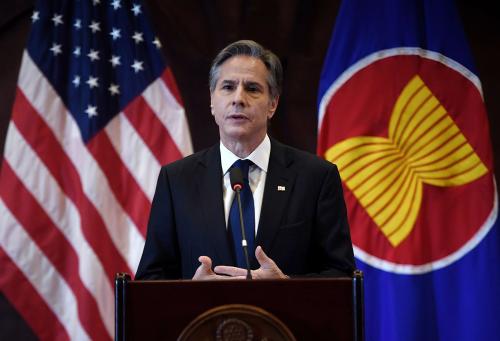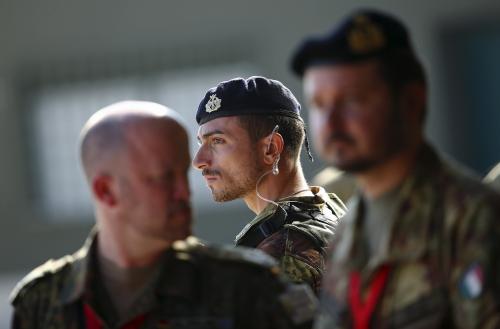The following is a summary of the 25th session of the Congressional Study Group on Foreign Relations and National Security, a program for congressional staff focused on critically engaging the legal and policy factors that define the role that Congress plays in various aspects of U.S. foreign relations and national security policy.
On October 28, 2022, the Congressional Study Group on Foreign Relations and National Security convened over Zoom to discuss the 2002 Iraq Authorization for Use of Military Force (“AUMF”). Originally enacted to authorize the U.S.-led invasion of Iraq in 2003, the 2002 AUMF has remained on the books for more than two decades and been cited—but not exclusively relied on—in relation to several military actions since. This session explored the interpretation and application of the 2002 AUMF and the potential impact of current proposals for its repeal.
The study group was joined by two experts on this topic: the study group coordinator, Scott R. Anderson, who is a fellow at the Brookings Institution and Columbia Law School and was previously an attorney-adviser at the U.S. Department of State and legal advisor for the U.S. Embassy in Baghdad, Iraq; and Brian Finucane, a senior adviser at International Crisis Group who was also previously an attorney-adviser at the U.S. Department of State focusing on political-military issues.
Prior to the discussion, the study group circulated the following background readings:
- Authorization for Use of Military Force Against Iraq Resolution of 2002, Pub. L. No. 107-243 (Oct. 16, 2002);
- The White House, Report on the Legal and Policy Frameworks Guiding the United States’ Use of Military Force and Related National Security Operations (Dec. 2016);
- Scott R. Anderson, “Did the President Have the Domestic Legal Authority to Kill Qassem Soleimani?,” Lawfare (Jan. 3, 2020);
- Ryan Goodman and Steve Vladeck, “Why the 2002 AUMF Does Not Apply to Iran,” Just Security (Jan. 9, 2020); and
- Brian Finucane, “Putting AUMF Repeal Into Context,” International Crisis Group (June 25, 2021).
Anderson also appeared on an episode of the Lawfare Podcast discussing these same issues. Later, he also published a two-part series in Lawfare on these issues that drew from the study group’s discussion.
The presenters began by describing the 2002 AUMF’s origins in the leadup to the 2003 invasion of Iraq. Despite the George W. Bush administration’s initial preference for a document that was more open-ended, the final measure reflected some constraints included by Congress. Those constraints included requirements that the President make certain procedural certifications to Congress and affirm that diplomacy was inadequate to meet threats and imposed regular reporting obligations on the executive branch. The text of the 2002 AUMF is broad, the presenters said, but authorizes enforcement of United Nations Security Council resolutions and defense of the United States from threats emanating from Iraq.
The presenters then discussed the broad scope of activities pursued under the 2002 AUMF. In addition to anticipated operations against Iraqi regulars and irregulars, U.S. and allied military forces also pursued operations against a diverse array of actors, including foreign fighters, tribal groups, militias, and other organizations. They also relied on the 2002 AUMF as authorization for the post-invasion assumption of the responsibilities of an occupying power, including deterring hostilities against Iraq, securing Iraq’s territorial integrity, taking responsibility for Iraqi airspace, and preserving public order.
By the end of 2008, the presenters explained, the United States had entered a bilateral security arrangement with Iraq, whereby Iraqi forces assumed leading roles in some operational tasks while certain other operations continued independently of the Iraqi government. By 2011, the U.S. withdrew after it failed to reach an agreement with the Iraqi government regarding the presence of U.S. troops in Iraq. Various military activities that occurred in Iraq during these periods were pursued under the 2002 AUMF, including counterterrorist operations targeting both al-Qaeda associated groups and Iran-backed militias.
Following the withdrawal of U.S. troops in 2011 through 2014, the Obama administration declined to rely on the 2002 AUMF for any military operations. But in 2014, the Obama administration initiated airstrikes targeting the emerging Islamic State in Iraq and the Levant (ISIL) in both Iraq and Syria. The administration relied initially on Article II of the U.S. Constitution, but eventually started advancing legal arguments grounded primarily in the 2001 AUMF that Congress enacted after the September 11th terrorist attacks but secondarily on the 2002 AUMF. The executive branch has since argued that the language of the 2002 AUMF, which permitted action taken against threats from Iraq, could support combatting terrorist threats in Iraq; subsequent congressional appropriation of funds for these operations were cited as ratification for these legal arguments. The Trump administration continued relying on the 2002 AUMF as supporting authority for the counter-ISIL campaign. But it also cited it as legal authority for targeting Iran-backed militias in Iraq as well as the 2020 strike that killed Iranian official Qassem Soleimani. The Biden administration, by contrast, has declined to rely on the 2002 AUMF for anything other than counter-ISIL operations and has endorsed its repeal on the logic that repeal would not impact ongoing U.S. military operations.
The presenters noted that the interpretive methodology used by the executive branch as well as the broad scope of activities that the executive branch has pursued under it lend themselves to very broad interpretations, potentially including for the use of substantial military force against a wide variety of threats so long as there is some nexus to Iraq. This arguably includes various Iranian and Iran-backed forces. The repeal or a narrowing of the 2002 AUMF by Congress would limit the existing risk that the executive branch could pursue such action without seeking Congress’s support. But it would not impact current ongoing military operations nor undermine the executive branch’s ability to defend U.S. personnel, as the President’s authority under Article II of the Constitution reaches most relevant self-defense scenarios.
Following the experts’ initial remarks, the study group transitioned to open discussion. Issues raised included: the prospects for a repeal of the 2002 AUMF; the role of Article III courts in interpreting these issues; presidential authorities in the absence of congressional authorization; and the use of the appropriations process in congressional oversight.
Visit the Congressional Study Group on Foreign Relations and National Security landing page to access notes and information on other sessions.
![U.S. Secretary of State Colin Powell holds up a vial that he described as one that could contain anthrax, during his presentation on [Iraq] to the U.N. Security Council, in New York February 5, 2003. [Powell tried to persuade a sceptical world that Iraq is concealing it's weapons of mass destruction and that force may be necessary to disarm it.]](https://www.brookings.edu/wp-content/uploads/2022/12/2003-02-05T120000Z_553139269_PBEAHUORSAU_RTRMADP_3_POWELL.jpg?quality=75&w=1500)


